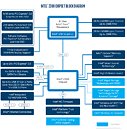Sunday, May 13th 2018

Intel Z390 Express Chipset Detailed
Intel released a product brief of its premium mainstream-desktop (MSDT) chipset, the Z390 Express. Positioned above the Z370 Express, the chipset has an exhaustive feature-set. It supports current 8th generation Core "Coffee Lake" processors, and is ready for the next-generation. Like all other 300-series chipsets, the Z390 interfaces with the LGA1151 processor over a DMI 3.0 chipset-bus. Much like the Z370, it features 24 downstream PCI-Express gen 3.0 lanes. Its storage setup remains unchanged from the Z370 - six SATA 6 Gbps ports with AHCI and RAID support; and up to three 32 Gbps M.2/U.2 connectors.
The differences begin with the chipset's integrated USB connectivity. The Z390 Express directly puts out six 10 Gbps USB 3.1 gen 2 ports, and ten 5 Gbps USB 3.1 gen 1 ports. If that's not a lot, it also puts out fourteen USB 2.0 ports (a total of 30 USB ports). Another major feature is Intel SmartSound technology, which the document specifies as an "audio/voice offload" DSP. This should, in theory, reduce the CPU's load in processing the audio stack. At the physical level it's still the company's "Azalia" HD audio bus wired to an audio CODEC with close to zero native signal processing. Perhaps some of that processing is done inside the chipset. The concept appears to be borrowed from edge-computing, and triggered by the rise in voice-command interface, so the chipset can natively process speech-to-text conversions.With the Z390 Express, Intel is also updating the platform's networking feature-set. The chipset supports a 1 GbE MAC interface, and recommends motherboard manufacturers to include an Intel Wireless-AC 9560 card, with 802.11ac and Bluetooth 5. Almost every Z390 motherboard will feature wireless networking, and most of them will include Intel's recommended WLAN card pairing. No new CPU overclocking features are detailed in the document.
The differences begin with the chipset's integrated USB connectivity. The Z390 Express directly puts out six 10 Gbps USB 3.1 gen 2 ports, and ten 5 Gbps USB 3.1 gen 1 ports. If that's not a lot, it also puts out fourteen USB 2.0 ports (a total of 30 USB ports). Another major feature is Intel SmartSound technology, which the document specifies as an "audio/voice offload" DSP. This should, in theory, reduce the CPU's load in processing the audio stack. At the physical level it's still the company's "Azalia" HD audio bus wired to an audio CODEC with close to zero native signal processing. Perhaps some of that processing is done inside the chipset. The concept appears to be borrowed from edge-computing, and triggered by the rise in voice-command interface, so the chipset can natively process speech-to-text conversions.With the Z390 Express, Intel is also updating the platform's networking feature-set. The chipset supports a 1 GbE MAC interface, and recommends motherboard manufacturers to include an Intel Wireless-AC 9560 card, with 802.11ac and Bluetooth 5. Almost every Z390 motherboard will feature wireless networking, and most of them will include Intel's recommended WLAN card pairing. No new CPU overclocking features are detailed in the document.

50 Comments on Intel Z390 Express Chipset Detailed
Here's an example of the flexible I/O architecture:
As you can see, out of the 10 USB 3.0 ports in this case, four are shared with PCI Express and two of those four are also shared with Gigabit Ethernet.
Obviously some of this can be software switchable, but I don't know of any motherboard that shares a PCIe slot with a USB 3.x port. However, many boards share SATA with M.2 for example.
What we don't know at this point is how many flexible I/O "ports" that the Z390 chipset will have and thus it's hard to say what the potential outcome of ports could be.
And looking at H370, which is the same silicon as Z390, the bandwidth seems to be enough for only a total of 4x Gen1 and 4x Gen2 ports. Plus all those 2.0 ports.
AMD's 300 serise chipsets have native USB 3.1(G2).
www.techpowerup.com/reviews/AMD/Ryzen_7_1800X/3.html
Also X470 has native USB 3.1(G2).
Also Intel's new H/B 300 serise chipsets also have native USB 3.1(G2)
Get your fact check before sperading misinformation.
See this Intel documentation PDF for details on this.
Even my relatively new DSLR doesn't even support USB 3.0.
The USB 2.0 ports are not part of the HSIO, as USB 2.0 is not considered high speed any more.
It makes sense from a logical standpoint of how we know things currently work, but maybe Intel made some changes to the flexible I/O.
Maybe Intel gimped it and limited to one PCIe 3.0 lane so we end up 8Gbps USB instead of 10Gbps. Would anyone really notice the difference? Even more so, if your current 10Gbps USB host controller is only connected to one PCIe 3.0 lane, you'd have the same limitation.
Looking at one of the few benchmarks I could find, it looks like this is exactly what they've done.
Source: www.kitguru.net/components/motherboard/ryan-martin/asus-rog-strix-h370-f-gaming-motherboard-review/10/
5th release on 14nm ...
Cannon Lake 10nm w. AVX512 where are you?
My audio setup: Schiit Lyr 3 tube amp - $565
headphone dac - modi multibit - $270
and my headphones, ZMF Blackwood Purpleheart wood - $750
thats good sound. ;p
lol
Thanks for the laugh!